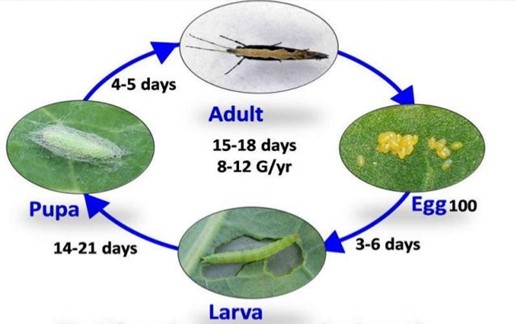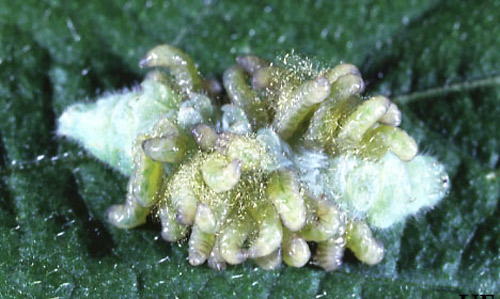The Diamondback moth(Plutella xylostella Linnaeus)is a worldwide migratory pest of the genus Cabbage Moth in the family Lepidoptera. It is found from northern America to northern India to China, and has a known host plant range of 35 species in 9 families. It is an oligophagous pest, with a particular preference for thick-leaved kale, cauliflower, cabbage and radish. In the absence of cruciferous plants, it can also feed on other host plants such as Asteraceae, Capparidaceae, Tropaeolaceae, Liliaceae, Boraginaceae and Oleaceae.

Hazard symptom
The moth larvae feed on the leaves, before the 2nd instar they can only eat the flesh of the leaves, leaving a layer of transparent epidermis, after the 3rd instar they can eat the whole leaf, forming holes and notches.
Older larvae feed rapidly and in large quantities, with the lightest of leaving holes on leaves and the heaviest of only veins remaining, often resulting in serious yield losses when seedlings are severely damaged.
In addition, insect droppings can also contaminate cauliflower and cauliflower, and the resulting wounds can easily cause soft rot.

Life cycle
The optimum temperature for the development of the diamondback Moth is 20-25°C and the relative humidity is around 76%, which is consistent with the suitable conditions for cruciferous vegetable cultivation. The moth can break out at any time from late spring/early summer to the autumn equinox, but there are two main periods (the peak of the pest) when the moth is heaviest and most concentrated in field vegetables, one being May-June and the other August-September, with June and September being the two most serious months for the moth and the two periods when control should be focused on high temperatures and rain. In July and August and October, when the weather becomes colder, the number of moths in the field will be significantly reduced.

Prevention and control measures
(1) Agricultural control
Covering the whole process with insect-proof nets is recommended to reduce the insect population or to protect the natural enemies of the moth, which are very important and can be use to keep the moth population at a low level for a long time without causing economic losses or damage.
(2) Biological control
Plutella xylostellagranulosis virus can be used. Use 20-30 larvae of the last instar infected with this virus (about 3-5g) per mu, pound and mix with 40-50L of water, and spray on both sides of the leaves of cruciferous vegetables at the 1st~3rd instar stage of the larvae, when 100 plants have 10 to 100 insects. The cabbage is sprayed 1-2 times from planting to harvest, and the cauliflower, kale and mustard are sprayed 3-4 times from planting to harvest, each time with an interval of 15 days. Other biological agents are Beauveria bassiana, Metarhizium anisopliae, Bacillus thuringiensis, Helicoverpa armigera nuclear polyhedrosis virus (HaNPV) and so on.

(3)Chemical control
Because of the short development period, the number of generations and overlapping generations, no overwintering and over-summering phenomenon. Therefore, pesticide use is frequent and resistance develops extremely quickly, and the Diamondback moth is the most resistant of all pests.
we recommend use Kenvos killer (Chlorantraniliprole 200g/L)
After 3 days , insects blackened and died
How Diamondback moth harms vegetables,see the video